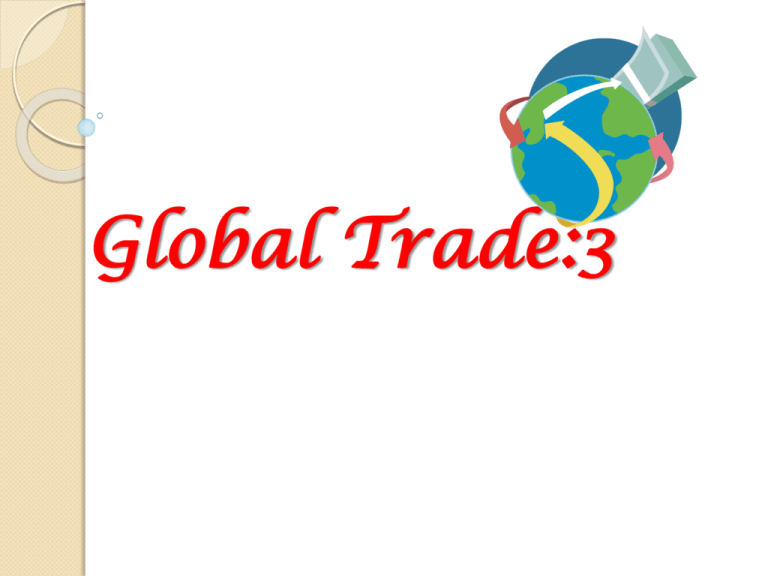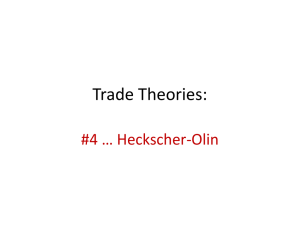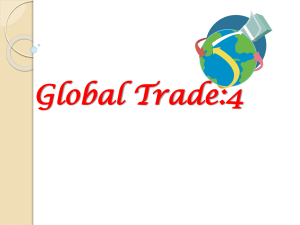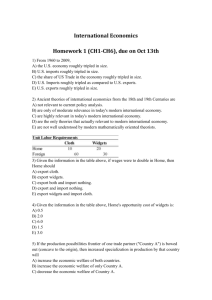
Global Trade:3
Global Trade: Lessons
Lessons
Topics
Lesson 1
The World Economy and Global Trade:
An Overview and Stylized Facts on Global Trade
Lesson 2
Lesson 3
Lesson 4
Lesson 5
Lesson 6
Theories of International Trade-I:
The Ricardian Model:
Labor Productivity and Comparative Advantage:
Theories of International Trade-II:
The Heckscher-Ohlin Model:
Factor Endowments and Comparative Advantage
Theories of International Trade-III:
The Standard Trade Model and Gains from Trade
Combination of Labor Productivity and Factor Endowments
Policy Instruments of International Trade:
Tariffs, Export Subsidies, Import Quotas, Export Restraints
Policy Issues of International Trade:
1) Free Trade vs. Protectionism
2) Liberalization in Developing Countries
3) The Role of the World Trade Organization
2
Texts
Main Text: Required:
1. International Economics: Theory & Policy, Krugman, P.R., and Obstfeld, M.,
8th Edition, Pearson-Addison-Wesley.
Recommended:
1.
International Economics, Husted, S., and Melvin, M., 8th Edition, AddisonWesley.
2.
International Economics, Gerber, J., 5th Edition, Addison-Wesley.
3.
World Trade and Payments: An Introduction, Caves, R.E., Frankel, J.A., and
Jones, R.W., 10th Edition, Pearson-Addison-Wesley.
4.
The World Economy: International Trade, Yarbrough, B.V., and Yarbrough,
R.M., 7th Edition, Thomson-South-Western.
5.
Principles of Microeconomics, Only Chapter 3: Interdependence and the
Gains from Trade, Mankiw, N.G., 5th Ed., South-Western Cengage Learning.
3
Lesson 3
Lesson 3: Global trade theory-II: The Heckscher-Ohlin Model of
Comparative Advantage
Procedure: The PowerPoint Presentation
Duration: 60 minutes
Overview
This lesson helps understand the Heckscher-Ohlin
model of comparative advantage based on
differences in resource endowments, and the
relevant concepts and tools: the curved production
possibility frontier, production and consumption
decisions, and gains from trade.
4
Lesson 3 (cont.)
Outline
List of Class needs: the text, a computer, and a notebook.
Pre-class reading and preparation: Chapter 4 of the text.
Activities and timing: Go over the entire presentation in 60
minutes and think about the main findings of the lesson.
Draw the diagrams shown in the lesson.
Identification of Learning Objectives: Objective #3 from
Section I
Identification of the Global Workforce Skills for the lesson:
Skill point #3 in Section II
5
Lesson 3 (cont.)
Outline
Lesson notes and suggestions for Instructors: Read
the relevant chapters in the recommended texts
and look for online data for the latest figures of
global trade.
Acknowledgment: The Course Developer took help of
different sources as referred while preparing the study
materials. When a considerable number of diagrams have
been developed to enhance interest in the subject, many
diagrams come from the required text for the convenience
of the students.
6
Comparative Advantage based on
factor endowments
In the previous lesson, we saw how
comparative advantage determined the
direction of trade based on simply and only
labor productivity.
Canada exports forest products to the U.S.
not because its lumberjacks are more
productive relative to their U.S. counterparts
than other Canadians but because sparsely
populated Canada has more forested land
per capita than the U.S.
7
Comparative Advantage based on
factor endowments (cont.)
A realistic view of trade must allow for
the importance not just of labor, but of
other factors of production such as land,
capital, and mineral resources.
This lesson examines a model in which
resource differences are the only source
of international trade.
8
Comparative Advantage based on
factor endowments (cont.)
Developed by two Swedish economists, Eli
Heckscher and Bertil Ohlin (Ohlin received
the Nobel Prize in economics in 1977), the
theory is called the Heckscher-Ohlin
Model/Theory (Henceforth the HO model).
This model shows that comparative
advantage is influenced by the interaction
between nations’ resources and the
technology of production.
9
The Heckscher-Ohlin (HO) model
The HO model argues that differences in
labor, labor skills, physical capital, land or
other factors of production across
countries create productive differences
that explain why trade occurs.
Countries have a relative abundance of
factors of production. Production
processes use factors of production with
relative intensity.
10
The HO model (cont.)
Assumptions:
The supply of labor services and land in
each country is constant. Only two goods
are important for production and
consumption: cloth and food.
Only two countries are modeled:
domestic and foreign.
11
The HO model (cont.)
Definitions:
aTC = hectares of land used to produce one m2 of
cloth
aLC = hours of labor used to produce one m2 of cloth
aTF = hectares of land used to produce one calorie of
food
aLF = hours of labor used to produce one calorie of
food
L = total amount of labor services available for
production
T = total amount of land (terrain) available for
production
12
The HO model: The PPF
13
The HO model: The PPF (cont.)
Let’s assume that each unit of cloth production
uses labor services intensively and each unit of
food production uses land intensively:
◦ aLC /aTC > aLF/aTF
◦ Or aLC /aLF > aTC /aTF
◦ Or, we consider the total resources used in each
industry and say that cloth production is labor intensive
and food production is land intensive if LC /TC > LF /TF.
This assumption influences the slope of the
production possibility frontier:
14
The PPF without factor substitution
15
The PPF with factor substitution
Actually, the opportunity cost of producing
cloth in terms of food is not constant. It’s
low when the economy produces a low
amount of cloth and a high amount of food.
It’s high when the economy produces a high
amount of cloth and a low amount of food.
Why? Because when the economy devotes
all resources towards the production of a
single good, the marginal productivity of
those resources tends to be low so that the
(opportunity) cost of production tends to be
high.
16
The PPF with factor substitution (cont.)
In this case, some of the resources could
be used more effectively in the
production of another good
If producers can substitute one input for
another in the production process, then
the PPF becomes curved.
17
The PPF with factor substitution (cont.)
If land can be substituted for labor and vice versa, the PPF no
longer has a kink. But it remains true that the opportunity
cost of cloth in terms of food rises as the economy’s
production mix shifts toward cloth and away from food.
18
Prices and production
The PPF describes what an economy can produce,
but to determine what the economy does produce,
we must determine the prices of goods.
In general, the economy should produce at the
point that maximizes the value of production, V:
V = PCQC + PFQF
where PC is the price of cloth and PF is the price of
food.
19
Prices and production (cont.)
Let us define an isovalue line as a line
representing a constant value of
production, V.
V = PCQC + PFQF
PFQF = V – PCQC
QF = V/PF – (PC /PF)QC
The slope of an isovalue line is – (PC /PF)
20
Prices and production (cont.)
The economy
produces at the point
that maximizes the
value of production
given the prices it
faces; this is the point
that is on the highest
possible isovalue line.
At this point, the
opportunity cost of
cloth in terms of food
is equal to the relative
price of cloth, PC /PF
21
The HO model and trade
Suppose that the domestic country is
abundant in labor services and the foreign
country is abundant in land: L/T > L*/ T*.
Recall that food production is land
intensive and cloth production is labor
intensive.
Because the domestic country is abundant
in labor services, it will be relatively
efficient at producing cloth because cloth
is labor intensive.
22
The HO model and trade (cont.)
Since cloth is a labor intensive good, the
domestic country’s PPF will allow a higher
ratio of cloth to food relative to the
foreign county’s PPF.
At each relative price, the domestic
country will produce a higher ratio of
cloth to food than the foreign country.
The domestic country will have a higher
relative supply of cloth than the foreign
country.
23
The HO model and trade (cont.)
An economy is predicted to be relatively
efficient at (have a comparative advantage
in) producing goods that are intensive in its
abundant factors of production.
An economy is predicted to export goods
that are intensive in its abundant factors of
production and import goods that are
intensive in its scarce factors of production.
This proposition is called the HeckscherOhlin theorem.
24
Summary points
Limitation of comparative advantage
based on only labor productivity
The Heckscher-Ohlin model: Comparative
advantage based on factor endowments
Factor substitution and the curved PPF
Isovalue line and the production decision
Predicting who will export and who will
import.
25
Activity/Homework
1.
Give at least three examples where the
HO model can be applied.
2.
Discuss the trade of computers and
garments between the U.S. and
Bangladesh in the light of the HO model.
26









